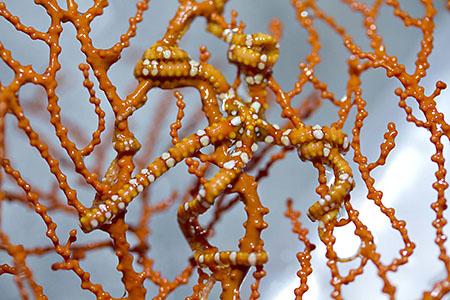Seized by a sneeze - more from Kristie Cobb Hacke
 Monday, January 24, 2011 at 5:39AM
Monday, January 24, 2011 at 5:39AM AD - Its clear to me that Kristie is a repressed zoologist! Her pure joy at the sight of dozens of tiny brittle stars attached to a sea fan is the kind of emotion that drove many of us into marine science in the first place. But don’t take my word for it…
________________________________
When I was a kid I used to spend hours thinking about how small we are in a really big world. I would often ponder “what is at the end of the universe?” I would amuse myself by thinking things like “it’s a brick wall” and then assume if you walked around or knocked it over there was always something on the other side. I would have this same thought again and again sometimes stopping to pause and wonder if it is something just like a big brick wall and there is no other side. When I was in high school these thoughts were shared by some of my friends as we circulated and chatted about Douglas Adams and his version of the universe and the restaurant at the end.
Another popular thought of mine was that earth was created by a giant sneeze. Sometime in middle school biology a teacher posed the thought that there could be whole universes in something as small as a pin-head. I had this great vision of the giant humans, one standing in front of another being seized by a sneeze. This uncontrollable sneeze produced projectile droplets that landed on the other person’s glasses. Although the term “yuck” is the first thing that comes to mind the second was always….”what if that just created a whole universe?” Would some small organism in that universe consider the edge of the droplet the end of the universe? Would they push on to see what was on the other side? Would they live and die a whole lifetime in the instant between the sneeze and the inevitable wiping of the lens?
From the collection boxes of the Sea Link II the scientists brought up a bio-box of goodies. Their samples included a beautiful gorgonian sea fan. As they unloaded, documented and photographed the various items, they pointed out many beautiful teeny-tiny brittle stars on the single fan sample. One of the researchers suggested that the sample piece contained more than 30 of the sea stars. Each of the sea stars was amazingly blended to hide themselves among the thin fan structure of the coral. Their fragile thin legs curled around the fan and, when coupled with their patterning, it created the perfect camouflage. The researchers were amazingly accommodating and allowed me to touch and handle one of the sea stars and a piece of the coral. As I carefully unwound an arm I had a stunning flashback to the brick wall and the sneeze. I wondered instantly if to these sea stars is the edge of their universe the single fan, the whole coral colony, the structure to which it is attached or some expanse of sea floor?
 Camouflaged brittle star attached to a gorgonian
Camouflaged brittle star attached to a gorgonian
When you consider the ocean as a whole it is amazing to think about all the millions of places that are yet to be discovered. Not to mention the uncountable species yet to be recorded. There are new depths known only through scans just waiting to be explored by humans. This journey has allowed time for conversations about new technology being created and innovative ways to use existing technologies or commercial vessels for research applications. As each of these becomes available and is applied it will undoubtedly lead to new discoveries. As this continued, in our lifetimes alone, there are bound to be millions if not trillions of questions to be asked and hopefully answered. Although I doubt the answer to life the universe and everything is as simple as “42” and I certainly cannot claim to know if there is a brick wall waiting at the bottom of challenger deep just waiting to be knocked over. What I do know is that research and its concrete ability to pose and then answer questions is incredibly important to our full comprehension of both the universe and the deep.
AD - This relationship between the brittle star and the sea fan is a great example of how little we know about symbioses in the oceans. Clearly the two organisms are living in close association, but in what manner? Is it pure parasitism, whereby the brittle star benefits and the sea fan is damaged? Or is it commensalism, where the brittle star benefits and the sea fan is indifferent to its passenger? Is it maybe possible that there is some sort of mutual benefit that we are unaware of? As a parasitologist by training, how little we know about the these associations makes it hard for me to define my own field. So, while Kristie’s vision is a little broader than mine (scaling up from brittle stars to the edge of the known universe!), I mostly grapple with smaller questions of who makes out better in this little biological transaction, and how does the sum of those transactions across the diversity of animal groups serve to reinforce or undermine stability in the whole ecosystem.


Reader Comments